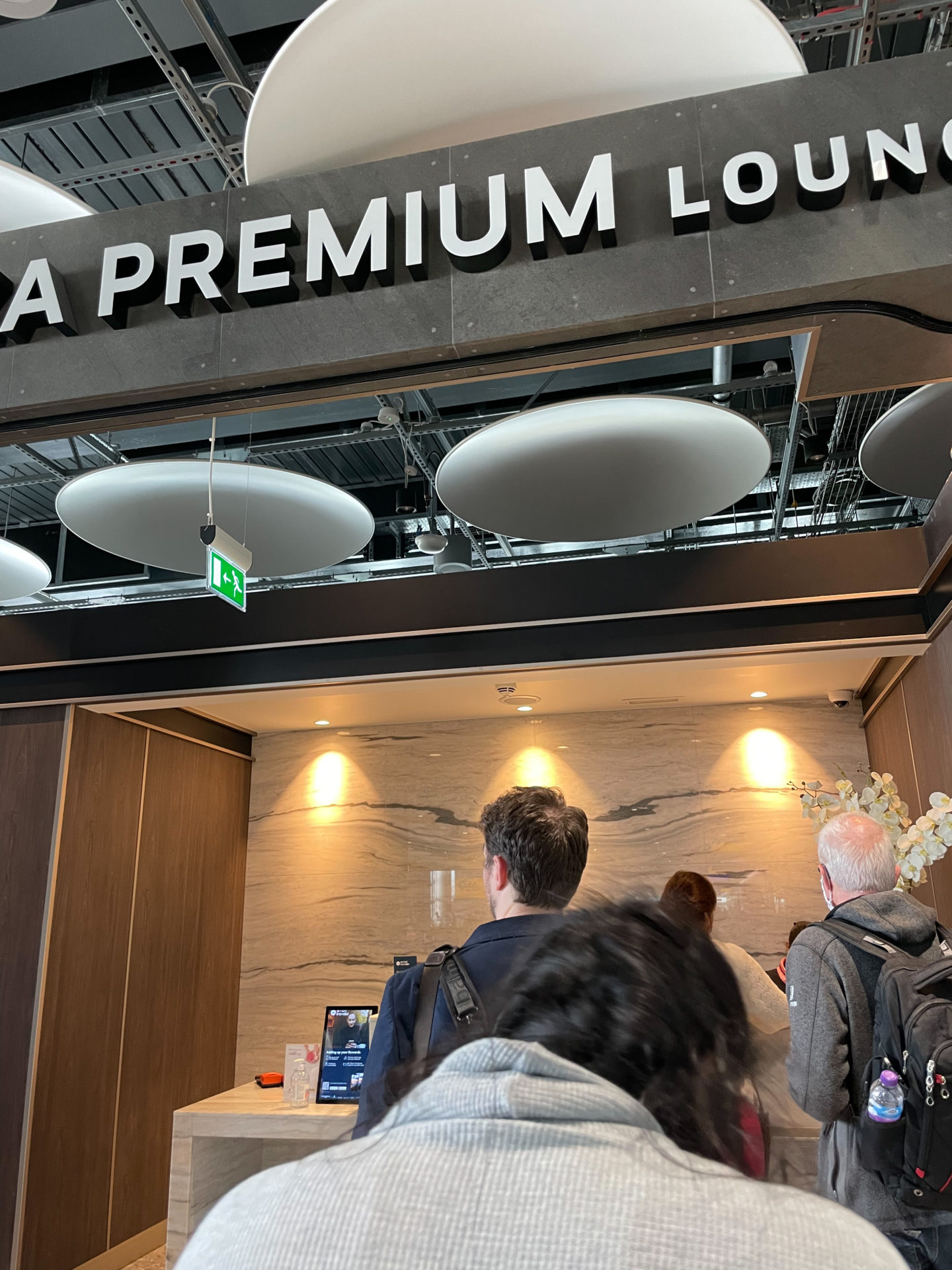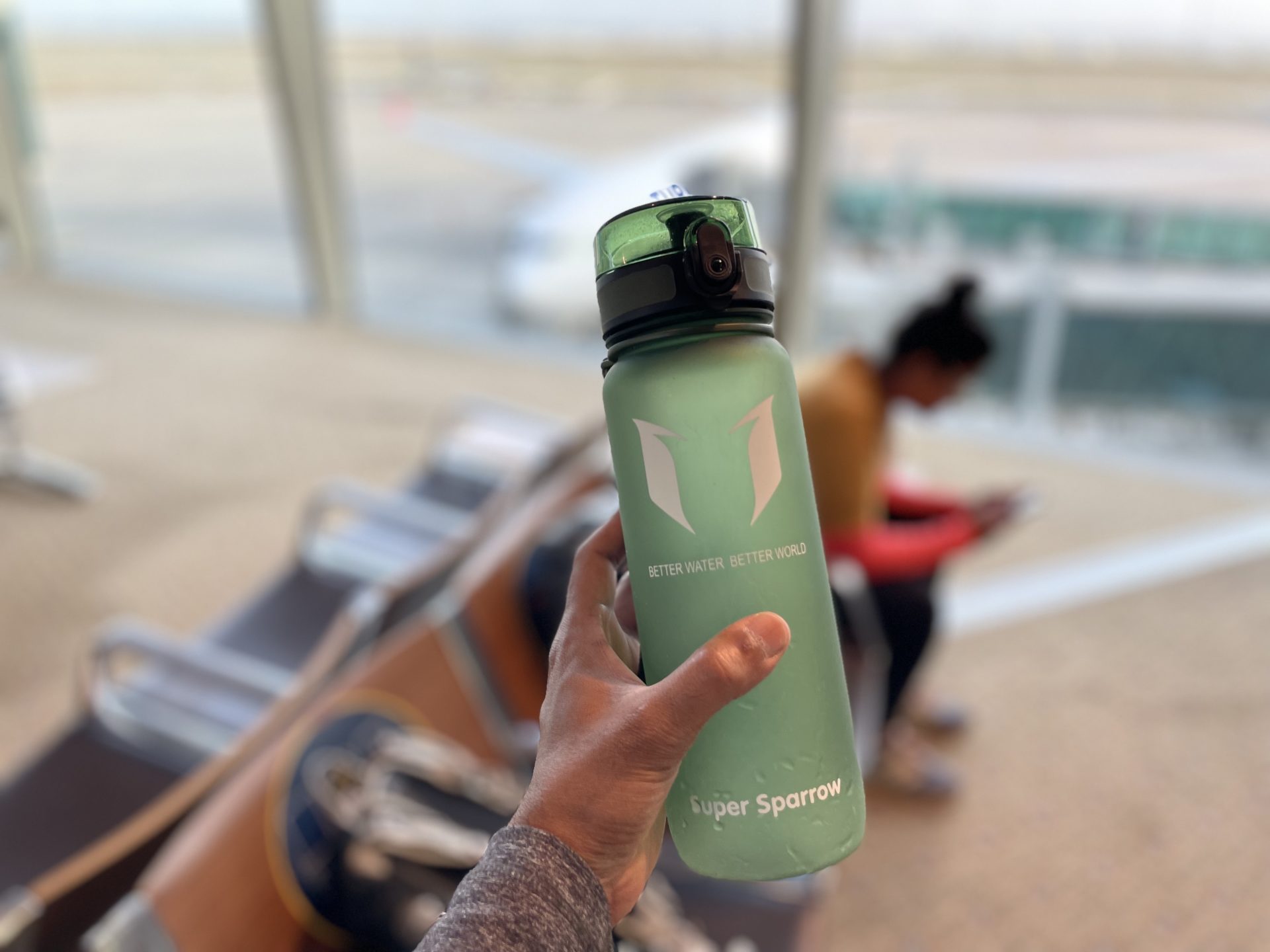Flying and traveling to exotic, far-off destinations during COVID can seem daunting, especially with so much uncertainty and change when it comes to testing.
But, after having safely traveled throughout the COVID pandemic, both within Canada and internationally for work and for pleasure, I’ve picked up a few flying pro-tips.
So, if you’re planning to fly somewhere soon, here are 7 hacks and tips to make your next flight a lot smoother during COVID.

1. Research and Utilize Airport Lounges
Most large domestic and international airports have one or more premium lounges. Premium airport lounges offer comfortable seating, fresh food, hot and cold beverages, and more peace and quiet compared to the main terminal seating areas.
So, if you get through security quickly, or have a long layover and are looking for a nicer place to relax before your flight, head to a premium lounge.
I used to think lounges are just for wealthy travellers. Yes, if your flight doesn’t come with lounge access, it can be quite pricey.
- A one-day airport lounge pass can cost anywhere between $30 to $90 depending on the airport and lounge type [Reference]
However, there’s a free way to get into these lounges, and we’ve used this method countless times…
It’s all about checking which credit cards grant you access to lounges for free! Visa, MasterCard and American Express all have free airport lounge access for their top-tier credit cards.
So, go through your wallet and cross-check if you have any lounge access-granting credit cards. Alternatively, if you travel a lot, consider upgrading your credit card so that you get more perks included.
On our recent trip to Jordan, we spent much of our 7 hour layover in London Heathrow Airport’s premium lounge and enjoyed complimentary food, drinks, and comfortable chairs to rest.

2. Select Airplane Seats Strategically
The thought of catching COVID on your flight to your destination, or back from it can be fairly stressful. The chances are low, but it’s still a possibility.
So how can you reduce the probability? Well, it helps if no one is sitting in your aisle, right!?
Now to increase the likelihood of no one sitting next to you, you have to select your seat strategically when checking into your flight:
- If you’re traveling solo, selecting the middle seat
- If you’re traveling with a partner, select the window and aisle seats
- Select seats near the back of the plane
When people see the middle seat is taken, or only the middle seat is available, they are less likely to select that seat. Likewise, most people prefer to sit at the front of the plane versus the back.
Then, eventually when you board your flight, you might get lucky and have an entire row all to yourself. You can lay down and sleep flat and get some much needed rest.
You can also literally breath a lot easier knowing you’re physically distancing from a potential COVID source.

3. Pack Instant Noodles
Comfort food, particularly when you’re traveling, is essential especially if you’re stuck on a packed plane for hours on end.
For us, a great way to sneak in a snack packed with deliciousness is to have a cup of instant noodles during our flight.
You just need to ask for hot water to be added to the cup. Even cutlery is provided by the airplane stewardess!
Trust me, a hot cup of instant noodles tastes so good on a plane. We’ve been doing it for years. It’s an inexpensive yet effective way to make any flight during COVID a lot more comfortable!

4. Use a Travel Pillow (Not a Neck Pillow!)
A lot of frequent flyers like to use a neck pillow to help them sleep on a plane. They seem to work for many people but they don’t seem work for us.
Instead, we opt to use a compressible travel pillow. In fact, it’s the same pillow we use for camping. Double use!
A compressible travel pillow is much more versatile and functional, not only during your flight but throughout your trip. It’s an extra comfy pillow for long bus rides, laying in the park, and sleeping in hostels.
Also, if you’re not sleepy, you can use the travel pillow to prop-up your lower back on uncomfortable airline seats.

5. Stay Properly Hydrated
Drinking enough liquids can be challenging for some people. It becomes especially challenging when flying.
Personally, I don’t drink enough water throughout the day sometimes, but if I’m flying I make a conscious effect to drink water more regularly. Being properly hydrated helps your body adapt to your changing environment, helps stave off sickness, and helps keeps you focused all throughout your trip.
So, there are a few ways to keep properly hydrated when flying:
Bring a Reusable Water Bottle
Whenever I travel, I carry my water bottle with me. And whenever I get the chance, I fill it up and continually sip water throughout the day.
In airports, water bottle filling stations are peppered throughout the gates, usually located near the washrooms or food court.
In my experience, a water bottle filling station in an airport should safe since it’s usually filtered or treated. I wouldn’t fill your bottle from a random water tap, which is important if you’re visiting a more remote or less developed part of the world.
For those instances, you’re better off purchasing bottled water. Unfortunately, a bottle of water can sometimes cost more than a can of soda in some places. Don’t let this tempt you though!
Pro-tip: If you’re looking for a the best water bottle for traveling, check out my review of the Tritan Sport water bottle by Super Sparrow!
Refrain from Consuming Caffeine and Alcohol
Some people rely on caffeinated drinks or alcohol to make their flight more enjoyable. On long-haul flights alcohol is free so why not, right?!
Well, drinking copious amounts of coffee, pop or alcohol can lead to dehydration, head aches, and can exacerbate jet-lag.
It’s best to limit intake of these types of drinks while flying to ensure your body can transition from one location to the next.
If you do end up drinking caffeine or alcohol, drink plenty of water as well – “dilution can be the solution”.
Pack Electrolytes
Another easy way to help keep your body hydrated why flying is by drinking electrolytes with water.
Electrolytes are minerals that help regulate the amount of water in your body, and ensure muscle and nerve tissue are working correctly.
Many times if we’re traveling we are deficient in electrolytes which can lead to cramping, headaches, fatigue, or even digestive issues.
So, an easy way to get enough electrolytes into your body before, during, or after a flight, is by adding an electrolyte tablet into your water bottle.
Personally, we use Nuun electrolyte tablets. Not only do they taste great, they provide us with the right amount of crucial minerals we need when we’re away from home traveling or exercising.
6. Use Ear-Savers with a Mask
Mask mandates are constantly changing. Wearing a mask now depends on which airlines you fly with and countries you’re visiting.
For the most part, flying with a mask is meant to help protect you and other from spreading air-borne infections like COVID. But wearing a standard face mask on a flight can be challenging.
Mask that are held in place with ear loops can quickly become uncomfortable and even painful if they are left on too long.
So, if you’re on a long flight and need to wear a mask consider using ear savers. Ear savers hook onto the mask ear loops and spread the tension around your head instead of around your ears.
We recently used mask ear savers on a 12-hour flight to Jordan. It helped to keep the mask securely on our faces, and we felt no discomfort using them at all!

7. Better Ways to Combat Jet-lag
One of the biggest challenges of flying across the world is having to deal with the time difference and jet-lag.
Your body needs to adapt to the new time-zone quickly so your itinerary can stay on-track. It all boils down to staying awake and sleeping at the right times to transition and coax your body to the next time-zone.
But, how can you know when to sleep, or when to stay away, especially with lengthy layovers and super long flights?!
Well, there’s an app for that!
Use Time-Shifter App
We recently flew 12 hours to Jordan from Toronto, with a 7-hour layover in London. With three distinct time-zones, how the heck would we know when’s the optimal time to stay away or sleep?
Well, we ended downloading and using the Time-Shifter App. You just plug in your departure and arrival destination and time, as well as any stop-overs, and it outlines an optimal sleep schedule.
For us, we absolutely needed to adjust our bodies during the flights because we had a busy itinerary once we landed in Jordan. Thankfully, the Time-Shifter App worked as advertised and we felt zero jet-lag.
Consider Taking Melatonin
If you find it difficult to sleep on a plane, especially if you’re flying across multiple time zones, you may want to consider taking melatonin.
Melatonin is a naturally occurring hormone which helps regulate the body’s sleep and awake cycles.
- Taking melatonin can improve certain symptoms of jet-lag such as alertness and reduce daytime sleepiness and tiredness [Reference]
Short-term use of melatonin has no adverse side-effects in adults or children. However, it’s recommended to not drive 4-5 hours after taking it. So, if you’re picking up a car as soon as you land, make sure to give your body plenty of time in between ingesting melatonin.
Personally, I don’t have to take any melatonin supplements since I can sleep fairly easily on a plane. However, Chetna does need to take it from time to time, and it definitely helps her get some much needed rest on the flight!
This article contains affiliate links, which help support this blog at no cost to you!
